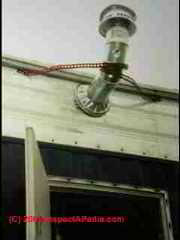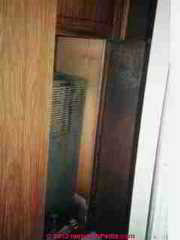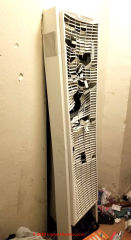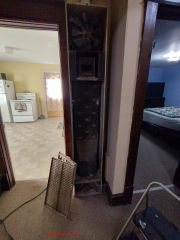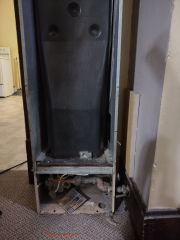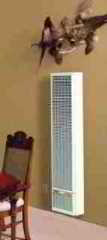 Wall-Mounted Furnaces & Heaters
Wall-Mounted Furnaces & Heaters
Inspect, trouble shoot, repair gas-fired wall heaters
- POST a QUESTION or COMMENT about wall-mounted direct-venting gas or oil furnaces
Wall mounted direct-venting gas-fired heating furnaces.
This article describes wall mounted furnaces used for home heating. Usually these are gas-fired direct-vent units such as the gas furnaces described in the text below.
We describe the installation fire clearances to combustibles, the use of an auxiliary blower unit, and the ability of the gas furnace to deliver heat without requiring external electrical power, permitting an area to be heated during a power outage or where electricity may simply not be available.
We discuss wall mounted furnace choices, installation, troubleshooting, safe flue gas venting, repairs. How do direct-vent gas fueled wall furnaces work? Use of auxiliary blowers with wall furnaces. Operation of the wall furnace during a power outage. Clearances to combustibles for wall-mount gas furnaces.
InspectAPedia tolerates no conflicts of interest. We have no relationship with advertisers, products, or services discussed at this website.
- Daniel Friedman, Publisher/Editor/Author - See WHO ARE WE?
Direct-Vent Wall-Mounted Gas Furnaces
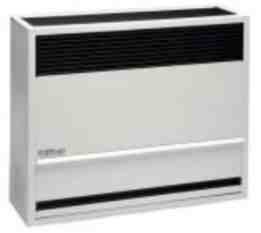 Shown at page top and at left are examples of gas-fired wall furnaces used for heating residential homes or in some cases mobile homes. These example furnaces are Williams wall furnaces.
Shown at page top and at left are examples of gas-fired wall furnaces used for heating residential homes or in some cases mobile homes. These example furnaces are Williams wall furnaces.
Shown here: Williams Furnace Corporation 22K/30K BTUh direct vent furnace.
[Click to enlarge any image]
The gas-fueled direct-vent wall-mounted furnaces described here are typically installed where point-source heat will be adequate to warm a living area and where no chimney is required (the units vent directly through a side wall).
Typical wall mount furnaces like the ones described here offer an added advantage of being able to provide heat during a power outage, as they can work without electricity.
The units all incorporate an automatic thermostat that can be used to control heat output.
Typical direct-vent gas fueled furnaces operate with output ranges between 15 KBTUh and 50KBTUh. The heaters vary in width from as little as 14" to about 36" and in height from about 27" to nearly 6. 5 feet depending on the manufacturer and model.
If your application needs greater heating capacity, higher BTUh output gas-fueled heaters may be sold by the same manufacturer in alternative models that require top-venting rather than venting horizontally directly through the building wall, offering outputs up to 65,000 BTUh.
Gas furnace models designed to operate at high altitude are also available. When evaluating the BTUh output of these gas-fired heaters, Trane notes that the input BTUH ratings are for elevations up to 2000 ft and that BTUH ratings (for U.S. installations) should be de-rated by 4% per 1000 feet above sea level.
For Canadian installations of such gas heaters Trane's BTUH input ratings are for up to 4,500 ft. and are de-rated 4% for elevations above 4,500 feet above sea level.
Adjustments to the BTUH data for other manufacturers may vary. - Trane (2003).
Auxiliary Blower Unit for Direct Vent Wall-Mount Gas Furnaces
A high-capacity blower fan, provided as an accessory, does require 115VAC and is sold as an additional feature that can increase the heat output and heat delivery speed for these units. But they can also work by convection without operating the blower fan.
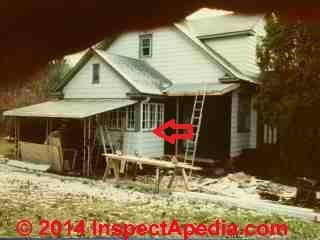 The gas heater can operate with or without the auxiliary blower if one is installed, so its presence does not prevent the delivery of heat should there be a power loss.
The gas heater can operate with or without the auxiliary blower if one is installed, so its presence does not prevent the delivery of heat should there be a power loss.
The auxiliary blower mount location varies but is typically attached to the top of the furnace and includes separate on-off or automatic controls. Some wall mount furnaces also include a rear-outlet register suitable for some installations.
I [DJF] first installed one of these direct vented, wall-mounted gas furnaces in an un-heated sunroom addition of a Fishkill, New York Home in 1983.
What had been a porch that was later enclosed had been an un-heated area of the home shown at left (red arrow).
Shortly after the project was complete, the owners experienced a power outage that lasted several days.
They reported being quite happy to be able to retreat to the newly-completed and warm sunroom of the home where the heater operated without a requirement for external electrical power.
Wall Mount Furnace Installation Specifications
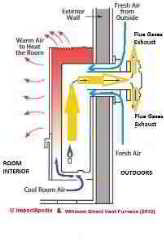 Using the Williams Furnace Company models as an example, typical clearance distances are
Using the Williams Furnace Company models as an example, typical clearance distances are
- 2 inches from the intersecting wall
- 18 inches between the top of the heater and the ceiling or any other obstructions (14,000 BTUH models)
- 24 inches between the top of the heater and the ceiling or any other obstructions (22,000 BTUH & 30,000 BTUH models) - Wall Mount - Williams Furnace Company (2012)
Larger, taller wall-mount furnaces of this type can be installed with zero clearance to the finished floor and as closely as 2-inches to the ceiling or overhang, depending on the furnace model.
[Click to enlarge any image]
The wall furnace vents the LP or natural gas fuel combustion gases through a horizontal wall vent to the building exterior.
Because the furnace is designed to accept combustion air from outside and to vent combustion gases directly back to the outdoors, the combustion chamber is sealed from room air, minimizing the risk of escape of flue gases or dangerous carbon monoxide to the room interior.
The wall furnace vent installation should include a vent shield and a vent-cap guard to protect against entry into the vent by birds or other animals - an event that could occur when the unit is idle and the vent is cool, and an event that could block the flue, preventing safe operation of the unit.
For thicker building walls the horizontal vent can be extended up to 24-inches.
For very thin building walls (such as in a mobile home where permitted by local codes), a thin-wall collar kit adapts the heater's vent system to walls from 1" to 5" in thickness.
Watch out: both for safety and to avoid a building code violation, check with your local building department about building permit requirements, inspections, and code compliance before purchasing much less installing any heating systems in your home.
Direct-Vent Wall Mount Gas Furnace Operation
The illustration at left, adapted from Williams Furnace Company, illustrates both the heating of room air by the gas furnace (the red area) and the direct-venting through the side wall (yellow areas).
On a call for heat a piezoelectric igniter lights the LP gas or natural gas gas burner inside of the combustion chamber.
Combustion air for the gas burner enters from outside (blue arrows around the exhaust vent in the right of the illustration), and combustion gases exit through the wall, passing through the exhaust vent to outdoors (large yellow arrows).
Cooler room air enters at the bottom of the furnace (dark blue arrows at the bottom of the heater), and is warmed by heat transferred through a steel heat exchanger to the room air as it passes upwards by natural convection to exit into the room through the front and top of the heater (red area and arrows).
If an auxiliary 115VAC blower unit is installed the blower increases the rate of air movement through the furnace.
Exhaust vent sizes vary by manufacturer and by heater type.
The power-vented the Trane units we reviewed used round vent diameters of just 2-3" while naturally-vented units used larger exhaust vents. Note that direct-vent gas furnaces that use power-venting will require 120VAC at all times.
Inspecting Gas Fired Wall Mount Heaters
Below: unsafe gas venting of a heater at a mobile home. Below right, oil fired heater in a mobile home closet. [Click to enlarge any image]
Watch out: Casey et als (1999) reported that the heating equipment most-often found in unsafe conditions in homes were gas-fired wall heaters.
- Check wall heater age & safety features: The authors pointed out that the safety worries are greater with older wall-heaters that may lack current safety features such as automatic gas shut-off controls and oxygen depletion sensors.
While you're at it, check the heater for a testing or approval label such as a UL Listing label affixed to the unit. - Check the wall heater location: The authors also discussed the permitted installation of these gas heaters in bedrooms, warning of installation in a room that is too small to provider adequate combustion air.
The Uniform Mechanical code allows a direct vent gas heater in a bedroom provided there is at least 50 cubic feet of air space per 1000 input BTUh of the heater.
The Williams heaters described on this page obtain combustion air from outdoors but older gas heaters may not.
The authors point out that doors should not open such that any part of the door is within 12-inches of the furnace and no horizontal projection should be within 18-inches of the heater. In some cases a home with a centrally-located direct-vent wall heater may not meet minimum property standards if those in turn require a heat source in each bedroom.
The building may meet this requirement by leaving bedroom doors open! Check with your local building department or if buying a home, with your mortgage company so that you don't face a costly surprise later.
- Check wall heater clearances & nearby combustibles:
When inspecting a wall-mounted gas heater extra attention should be given to the heater's location, clearances from combustibles, condition of the outer cover, exhaust vent termination, gas connections, burners, and heat exchanger.
Quite a few of us inspectors found heaters installed where a curtain or door or other combustible could come into contact with or block the heater - an unsafe condition. Note if nearby surfaces are becoming hot when the unit operates.
See details
at WALL-MOUNTED FURNACE CLEARANCES - Testing gas fired direct vent heaters for flue gas or fuel gas leaks: Inspectors properly trained and equipped can test for flue gas spillage into the occupied space, for heat exchanger damage or leaks, or for fuel gas leaks.
But all inspectors should at a minimum be able to spot visual evidence of unsafe conditions including burn marks, combustible clearance hazards, or equipment modifications.
Visual inspection should detect at least the conditions already listed above and in addition may detect (depending on access and site specific conditions):- Blower fan operation: if installed, does the fan operate properly
- Burn marks or other signs of overheating on the jacket, heat exchanger, around burners, around flue or flue vent connectors
- Combustion air adequacy: see comments above; also note air intakes blocked by debris, animal hair, carpets, furniture, etc.
- Damage: Evidence of physical or mechanical damage to the equipment, visible cracks in the heat exchanger
- Draft hood (diverter) blocked by anything; palpable (by touch, sensor, odor) spillage of flue gases out of the diverter after the initial warm-up interval
- Flame colour: yellow flame (poor air mix), flame abnormally high, lifting off burner, flame roll-out, etc.
- Gas odors or smells or visual signs of gas leaks (stains on piping connections, regulator, etc)
- Gas piping: wrong material, flexible lines run through walls, ceilings, floors, proper materials (the authors indicate that flexible copper tubing is not acceptable, citing risk of flaking and debris entering the gas valve)
- Leak and rust marks or stains
- Location of gas shutoff valves (may be inside the appliance for wall furnaces, not for other appliances
- Red tags: note presence of any red tags left by prior inspectors or service personnel: such equipment should normally be shut down and left off, with appropriate occupant and owner notifications and warnings.
- Venting, clearance inadequate, missing vent or chimney components (such as a cap or bird screen), or improper venting materials (aluminum, single-wall vents through attics, etc.)
Watch out: This heating system inspection including any tests that are performed cannot be a complete, comprehensive nor technically exhaustive inspection nor safety test of the equipment but it can reduce risks to building occupants. Remember to check for the presence of CO2 and Smoke detectors or alarms.
Our photos above show that goofy installation of heaters in a mobile home closet are not confined to gas fired units.
At above right, the heater in this mobile home closet was oil-fired.
See MOBILE HOME HEATING SYSTEMS
See HEATING FURNACE INSPECTION GUIDE for a complete index to inspecting & troubleshooting warm air heating systems.
Direct Vent & Un-Vented Gas Heater & Gas Furnace Information
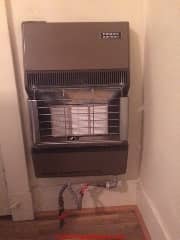 Photo: an Empire un-vented infrared wall heater, Empire Corcho, photo provided by an InspectApedia.com reader. [Click to enlarge any image]
Photo: an Empire un-vented infrared wall heater, Empire Corcho, photo provided by an InspectApedia.com reader. [Click to enlarge any image]
- MANUALS & PARTS GUIDES - HVAC - home- for all brands of heating equipment
- MANUALS for HEATING & A/C SYSTEM CONTROLS - for all brands of heating system controls, thermostats, relays, etc.
- Amana HVAC, "GUI / GCI Gas-Fired Warm Air Furnace Installation Instructions", Maytag Corporation, Licensed to Goodman Company L.P., - retrieved 12/8/2014, original source: http://amanafurnace.dnmech.com/lit/10759826.pdf
This appliance uses a Honeywell Model VR-8205, or White Rodgers Model 36E22 / 36E36 or Robertshaw Model 7222 gas control. The document includes a gas heater troubleshooting checklist. This is not a direct vent gas furnace. - EMPIRE HEATING SYSTEMS - Empire Comfort Systems Furnace Manuals, Empire Heating Systems, Empire Comfort Systems, Inc., 918 Freeburg Ave., Belleville IL 62220, USA, Website: www.empirecomfort.com, Tel: 1-800-851-3153
- Nagda, Niren L., Michael D. Koontz, Irwin H. Billick, Neil P. Leslie, and David W. Behrens. "Causes and consequences of backdrafting of vented gas appliances." Journal of the Air & Waste Management Association 46, no. 9 (1996): 838-846.
- Sears Corporation, "Sears Gas Furnace Service Hints", (1993), provided courtesy Jim Jagger, ASHI, Buckeye Home Inspections, Cleveland OH, Tel: 216-486-4663. Sears Gas-Fired "Space Saver"Furnace Models: 867.765030 - 867.775260.
See also SEARS / KENMORE HVAC AGE MANUALS & PARTS - Trane Corporation, "Upflow/Horizontal Left Downflow/Horizontal Right Condensing Direct Vent Gas-Fired Furnace" XR90 TUX040 - TUX120C Single-Stage Fan Assisted Combustion System, TUXC-D2, American Standard, Inc., (2003), Website: www.trane.com, Louisville Kentucky. Furnaces certified by AGA and CSA.
- WALL-MOUNTED FURNACE CLEARANCES - clearance distances from surfaces and materials indoors and at the exterior wall exhaust vent
- Williams Furnace Company, "Direct-Vent Furnaces", (2012) Williams Furnace Corporation, 250 West Laurel St., Colton CA 92324, USA, Tel: 909-825-0993, Consumers: 888-256-6465, Homeowners: 909-426-0978, Website: www.e-wfc.com
Heating equipment models produced by Williams include high efficiency direct vent furnaces, a Monterey Plus and Monterey home furnaces that are vertical wall-mounted units, other direct vent furnaces, Forsaire Counterflow furnaces, garage furnaces, vented-room console heaters, floor furnaces, "Vent free" heaters, and other models. - WILLIAMS GAS FURNACE MANUALS - free downloads of Williams Wall Furnace manuals.
- More citations: seeReferences or Citations
...
Reader Comments, Questions & Answers About The Article Above
Below you will find questions and answers previously posted on this page at its page bottom reader comment box.
Reader Q&A - also see RECOMMENDED ARTICLES & FAQs
On 2022-10-13 by InspectApedia-911 (mod) - smashed wall furnace is unsafe
@Mary Coughlin,
I wouldn't bet your life for anyone else's on turning on that wall furnace. It's been severely smashed and there's risk of both gas leaks as well as damaged venting, fire & safety controls.
On 2022-10-10 by Mary Coughlin
I installed a dual wall furnace in a rental property and the tenant damaged it by first trying to pull it off the wall and then used a crowbar or a sledgehammer on one side of the heater.
I see from other posts that it is recommended that it be checked annually. I was wondering if it is even safe to try to turn it on. the side of the wall where the pilot light is located is not the one that was damaged.
On 2022-09-08 by InspectApedia-911 (mod) - wall furnace is passing heat when pilot light is off
@Gerry,
First be sure that the blower fan itself is off not just the burner.
Then about checking your roof vent - in a properly working furnace there's absolutely no air connection between the flue gas exhausts produced by combustion and the duct work that's circulates air in your home.
If there's a hole in a furnace heat exchanger, there could be such a circulation but it would have to be pretty big hole for you to be feeling it as heat delivered to the occupied space..
You could ask a heating service technician to do a smoke test to confirm that there's no leak in your furnace. Keep me posted.
On 2022-09-07 by Gerry
Wall furnace is passing heat in to my hallway an my pilot light is off! IS the heat coming down through the exhaust vent on the roof?
On 2022-06-01 by InspectApedia-911 (mod) - Empire direct vent counter flow wall furnace works sporadically
@Ricardo,
I can but guess that
- there is too much gas released before ignition occurs, causing a larger than normal ignition "explosion" that is either blowing out the pilot or exhausting its air supply
- there is a blocked air intake to the furnace so ignition is briefly exhausting the combustion air supply
- there is a blocked exhaust vent for the furnace, such that back-pressure extinguishes the pilot
- the pilot itself is clogged and flame under-sized, or is askew or otherwise not properly mounted or functioning
Can you post a photo of the pilot flame and device?
On 2022-06-01 by Ricardo
I have an Empire direct vent counter flow wall furnace model DVC 40-SPP wall furnace installed in 2004. Service has been regular and the thermocouples replaced several times over the years. The unit ran perfectly for 15 years.
Over the past 8 years it has worked sporadically. When first lit and turned on it works great. When it turns on as the house temp cools it will often attempt to light with an ordinarily loud whoosh sound that stops the ignition and sucks the pilot off.
Local servicemen cannot find any obvious problem. What would cause this unit to not light and snuff the pilot light out? Unit is cleaned and with a new thermocouples.
On 2021-12-14 by Inspectapedia Com Moderator - air flow around the heating plenum
@John Joseph Gregurich,
Air flow around the heating plenum may be correct, so as to pick up heat from the heat exchanger but I need to emphasize that I don't have a clear, full understanding of your installation.
Look at the air handler and the blower assembly: usually the manufacturer includes an arrow indicating the proper rotation direction for the blower assembly. Running it backwards will deliver poor air flow and increase heating cost.
On 2021-12-13 by John Joseph Gregurich
I replaced the fan motor on my Dayton gas fired vertical wall heater. The fan blade rotates air toward the motor and then around the plenum, and then out the vents. Is this correct or should the fan just blow directly out the top vent?
On 2021-10-29 by inspectapedia.com.moderator - furnace remains on at highest temp
@carlos,
If by "thermostat" you refer to the wall thermostat, and if you're saying your furnace won't turn on until you turn the thermostat all the way "up" I suspect a control board error
in the furnace,
but you might first check for loose or damaged thermostat wiring itself by disconnecting the wires from the thermostat and connecting them together.
If the heat goes on as it should then I suspect the thermostat itself or its connections.
If heat does not go on as it should then I suspect the thermostat wires or the control board.
Then
make the same test at the other end of the thermostat connections, at the control board at the thermostat terminals
On 2021-10-29 by carlos
replaced thermostat. same problem. furnace ignites at highest temp and remains on. what could it be?
Question: how to turn on and operate a Wards wall-mounted gas heater
I just moved into an old apartment and I don't have any heat..
I believe that the picture I sent is the reason for the no heat.. but have no knowledge of how to work this type of heater. - Anonymous by private email 2022/02/19
Moderator reply:
That looks like a wall mounted gas heater that should be venting to the building exterior but I'm not sure it's kind of blurry. It may be that the electrical power to the heater is off or that its gas supply is off.
Reader follow-up:
Thank you for your time. It's pilot is lit. And vents out the attic to roof. I have never seen a unit like this.. there are no operators instructions unfortunately so if you have any useful knowledge for me I would greatly appreciated.
Hopefully this is a better picture to see - below.
Moderator reply: identify the heater brand and model and then download and review its operating instructions
It's a little dangerous to be trying to diagnose a heating system when I can't see it and don't know what it is. If your pilot light is lit it sounds as if you need to open a gas valve or turn up the thermostat to have heat.
Watch out: Make sure you have working smoke detectors and carbon monoxide detectors
I think I see a Wards data sheet in the bottom of that very dirty, poorly-maintained, possibly unsafe heater.
So take a look at that sheet and also look inside the cover door and around the rest of the accessible sides of the heater to confirm the brand and then find the model and serial number of the heater. That will let us find the installation and operation manual for the specific unit.
In my opinion the heater looks so dirty that it ought to be inspected for safety then cleaned and serviced, by a professional.
Also tell us the country and city where the heater is installed and the building age if you can.
On 2021-09-23 by inspectapedia.com.moderator - wall mounted furnace blower troubleshooting
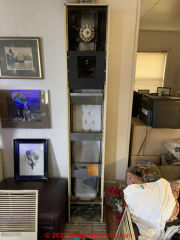 @Joe,
@Joe,
I don't quite understand the question, but if you mean that the blower in the air handler part of your furnace is blowing in the wrong direction that's often caused by improper installation - as simple as mounting a squirrel-cage fan backwards - and it is unsafe; leave the heater OFF and call for repair.
On 2021-09-23 by Joe
I have a wall mounted furnace that the motor was changed and it seems to blow the air down through the unit itself and knocked out the top and blows out the pilot light my other ones blow out the top and suck the cold air in from the bottom
On 2021-08-23 by inspectapedia.com.moderator - Basic safety inspection for gas fired wall heaters
@Cat,
Basic safety inspection for gas fired wall heaters
Important: I am not providing a complete safety check list for wall-fan-heaters, and it is likely that there are important additional safety checks that a trained heating service technician would and should perform that we're not listing here. You should have your heater checked by a trained service technician.
That said, some key safety points are below, assuming that we are discussing a natural gas or LP gas fueled wall-heater:
1. Be sure that you have properly-installed, properly-located, and regularly-tested smoke detectors and carbon monoxide detectors (CO detectors) in your home. This is a key line of defense against unsafe gas fueled heating equipment.
2. Because most gas heaters run pretty clean, people tend to go longer than they probably should between heating service calls that include an inspection, cleaning, and tuneup. If you've not had that done in the last year, schedule that service, and at its completion, ask your on-site service tech for her opinion about the frequency of such visits.
3. If you smell combustion products or gas indoors, if you can so safely, immediately turn off the gas supply to the building and power to the heater, then from outside at a safe location call for repair. The concern is for both a combustible or explosive gas leak and for a carbon monoxide poisoning hazard. CO itself is odorless but as it's likely to be mixed with combustion gases from the heater, if you smell such indoors there's a hazard to be investigated.
4. If on inspection you see sooting at or around the burner or the gas exhaust, the system is not operating properly and it is unsafe, risking dangerous CO production.
5. If you see burn marks anywhere in or around the equipment you should ask your heating service technician to take a look.
6. If you have UN-VENTED gas [portable?] space-heating equipment in my opinion and that of at least some others including the US CPSC, that equipment is unsafe and ought not be used.
See COMMISSION PROPOSES BAN ON UNVENTED GAS SPACE HEATERS [PDF] U.S. CPSC, (2016)
On 2021-08-23 by Cat
@inspectapedia.com.moderator, I won't be leaving the cover off, just pulled to clean and check if anything looked 'off' inside... but I don't know what 'off' would look like.
Thanks for responding!
okay. I have never owned wall fan heaters, new home to me, heater cover looked really dirty, perhaps burnt. The heater turns on and no sparks, the cover cleaned relatively well. I'm wondering if it was just dirty and old Dust or how to know if the heater burnt it...
How to check if wall heaters are safe to use in New to me home?
On 2021-08-22 by inspectapedia.com.moderator (mod) - danger of leaving cover off of the furnace
@Cat,
Not necessarily; some heater covers include a safety switch, intended to keep you from death by touching live electrical components - a switch that prevents the system from operating if its access cover is not in place.
On 2021-08-22 by Cat
If you take the cover off electric wall fan heaters, are the tines inside supposed to get red hot right away when you turn it on?
On 2021-05-21 by (mod) - how To immediately shut off your heater
@Marylou Kormann,
To immediately shut off your heater find the electric power switch that should be mounted on a wall or on the equipment close to the heater. If you can't find that switch you'll find a circuit breaker or fuse in your panel that brings power to the heater and you can turn off power at either of those locations.
But if your furnace is not turning off when it should then there's another problem such as shorted thermostat wires that need investigation.
In the article index your find a diagnostic article titled
Heat won't turn off
On 2021-05-20 by Marylou Kormann
How do i shut of my Williams direct vent wall furnace 1403822. The thermostat is turned off, but there is still heat coming out of the unit. It's heating up in Ontario Canada
On 2021-05-07 by (mod)
@Barbara,
I would need to see some photos and have more detail to understand your wall heater and whether or not there is a problem there. I certainly would not add plywood or any other combustible material to an existing heater because of the possibility of a fire hazard. I also would be concerned about blocking combustion air which could in turn caused the production of fatal carbon monoxide.
On 2021-05-05 by Barbara
I have a wall mounted heater..there is a hole in the bottom for all the pipes and wires...however that eaves a hole directly over the basement..repairman told me have a handyman put a 1/2 piece of plywood over the hole..is that the correct info?
On 2021-01-02 by (mod) - an unsafe gas leak or igniter failure
David:
There is an unsafe gas leak or igniter failure; you should leave the heater off and call for repair; The risk is a gas explosion or fire.
On 2021-01-02 by David Clem
Why is the flames shooting up 2 feet before it lights the burner
On 2020-11-21 - by (mod) -
Is the gas valve is not opening problem could be a defective valve or a bad thermocouple
On 2020-11-20 by Greg
My old kresky wall furnace won't ignite when I turn up the thermostat it does have a pilot light lit though
On 2020-10-30 - by (mod) -
Is the gas burner igniting
On 2020-10-29 by Williams gas wall heater furnace
It first was the relay switch went out now i think dod again itll kickd on blower amd stuff but womt heat
On 2020-07-24 by mplomske@eastlink.ca
Are DV wall furnace compatible with either natural gas or propane?
On 2020-04-14 - by (mod) -
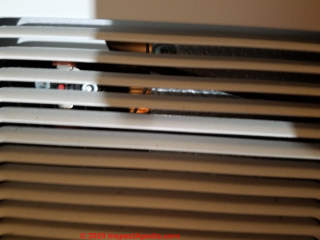 I want to help, Jackie but I do not know enough about your heater or what kind of heater it is to be able to have an opinion about whether it's normal or something that is unsafe.
I want to help, Jackie but I do not know enough about your heater or what kind of heater it is to be able to have an opinion about whether it's normal or something that is unsafe.
Perhaps you can attach a photo showing more of the heater and in another come out of photo of the heaters that attack.
If you are worried that the heater is on Safe it may be necessary to turn it off and call for emergency repair service.
It's also important to have working fire and smoke detectors and carbon monoxide detectors in your home.
On 2020-04-14 by Jackie
Why do heat always coming out the top part of the heater
On 2019-11-19 - by (mod) -
Possibly yes. For example a flue gas spill switch used on some gas fired heaters may have a manual reset button.
See details at FLUE GAS SPILL SWITCH TRIPPING & RESET
On 2019-11-19 by rob
do the safety featur on the williams wall heater need to be reset?
On 2019-09-06 - by (mod) -
Adora
A wall mounted furnace blows warm air into the room to heat it.
But if you meant to ask why outdoor air might be blowing into the room through the heater, that might be due to an improper mounting or air leaks around the heater's external vent or combustion air supply intake; that may be unsafe; ask for an inspection and repair by your heating service company.
On 2019-09-06 by adora
why is air blowing through this heater ?
On 2019-02-06 - by (mod) -
Dan:
First recognize that there could be a fire hazard - the building could catch on fire - or the heater may not be installed properly or not working properly.
That means turn the heater off until you know that it is safe.
Next: Identify the heater brand and model - check the heater's data tag.
Then give the manufacturer a call to find out if in their opinion there is a safety hazard.
While you're at it get the installation and operation manual for your specific heater to make it easy to check the installation specifications against your particular case.
If you cannot identify the heater brand and model and contact the manufacturer leave the heater off while you arrange a fire/safety inspection by a trained heating service technician for your heater type, presumably gas-fired but possibly electric or oil or other.
On 2019-02-05 by Dan
The wall on the back side of the wall heater gets very hot, what can i do about this
...
Continue reading at WALL-MOUNTED FURNACE CLEARANCES or select a topic from the closely-related articles below, or see the complete ARTICLE INDEX.
Or see WALL MOUNTED GAS FURNACE FAQs - questions & answers posted originally at this page
Or see these
Recommended Articles
- CARBON MONOXIDE WARNINGS: HOME HEATERS
- COMBUSTION AIR REQUIREMENTS
- DIAGNOSE & FIX HEATING PROBLEMS-FURNACE - home
- DIRECT VENTS / SIDE WALL VENTS
- FURNACE DIAGNOSTIC CHECKS, GAS
- MANUALS & PARTS GUIDES - HVAC - home
- NO HEAT - FURNACE
- WALL-MOUNTED FURNACES
- WALL-MOUNTED FURNACE CLEARANCES
Suggested citation for this web page
WALL-MOUNTED FURNACES at InspectApedia.com - online encyclopedia of building & environmental inspection, testing, diagnosis, repair, & problem prevention advice.
Or see this
INDEX to RELATED ARTICLES: ARTICLE INDEX to HEATING FURNACES
Or use the SEARCH BOX found below to Ask a Question or Search InspectApedia
Ask a Question or Search InspectApedia
Try the search box just below, or if you prefer, post a question or comment in the Comments box below and we will respond promptly.
Search the InspectApedia website
Note: appearance of your Comment below may be delayed: if your comment contains an image, photograph, web link, or text that looks to the software as if it might be a web link, your posting will appear after it has been approved by a moderator. Apologies for the delay.
Only one image can be added per comment but you can post as many comments, and therefore images, as you like.
You will not receive a notification when a response to your question has been posted.
Please bookmark this page to make it easy for you to check back for our response.
IF above you see "Comment Form is loading comments..." then COMMENT BOX - countable.ca / bawkbox.com IS NOT WORKING.
In any case you are welcome to send an email directly to us at InspectApedia.com at editor@inspectApedia.com
We'll reply to you directly. Please help us help you by noting, in your email, the URL of the InspectApedia page where you wanted to comment.
Citations & References
In addition to any citations in the article above, a full list is available on request.
- Beers, Jonathan. "Condensing Furnaces: Lessons from a Utility." Home Energy Magazine Online (1994).
- Brand, L. "Measure Guideline: Combustion Safety for Natural Draft Appliances Using Indoor Air." (2014).
- Casey, Michael & Hansen, Douglas, Robinson, Roger, "Wall Furnaces", CREIA Inspector (1999).
- Rapp, Vi H. "Assessment of literature related to combustion appliance venting systems." (2014).
- Roth, Dalene. "Gas Safety Information Bulletins." (2007).
- McWilliams, Jennifer, and Max Sherman. "Review of literature related to residential ventilation requirements." Lawrence Berkeley National Laboratory (2005). uot;, (2012) Williams Furnace Corporation, 250 West Laurel St., Colton CA 92324, USA, Tel: 909-825-0993, Consumers: 888-256-6465, Homeowners: 909-426-0978, Website: www.e-wfc.com
- Our recommended books about building & mechanical systems design, inspection, problem diagnosis, and repair, and about indoor environment and IAQ testing, diagnosis, and cleanup are at the InspectAPedia Bookstore. Also see our Book Reviews - InspectAPedia.
- In addition to citations & references found in this article, see the research citations given at the end of the related articles found at our suggested
CONTINUE READING or RECOMMENDED ARTICLES.
- Carson, Dunlop & Associates Ltd., 120 Carlton Street Suite 407, Toronto ON M5A 4K2. Tel: (416) 964-9415 1-800-268-7070 Email: info@carsondunlop.com. Alan Carson is a past president of ASHI, the American Society of Home Inspectors.
Thanks to Alan Carson and Bob Dunlop, for permission for InspectAPedia to use text excerpts from The HOME REFERENCE BOOK - the Encyclopedia of Homes and to use illustrations from The ILLUSTRATED HOME .
Carson Dunlop Associates provides extensive home inspection education and report writing material. In gratitude we provide links to tsome Carson Dunlop Associates products and services.


